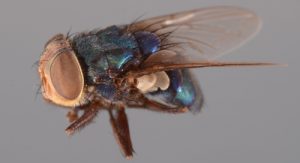In October of 2016, the United States Department of Agriculture confirmed that the primary screwworm, also called the New World screwworm, has returned to Florida. The fly was found infesting Key deer on Big Pine Key. Key deer are an endangered species found only on the Florida Keys, and unfortunately several have died from the 2016 screwworm infestations, but the screwworm is not only a problem for deer and other wildlife. The pest poses a serious threat to all warm-blooded animals, including livestock, pets, and people, and it cost the US livestock industry billions of dollars before it was finally eradicated decades ago. This four-page fact sheet provides more information about this dangerous pest and how to spot it, as well as what to do and whom to contact if you suspect an infestation in your livestock or pets or in a wild animal. Written by Phillip E. Kaufman, Samantha M. Wisely, and Jennifer L. Gillett-Kaufman and published by the Entomology and Nematology Department.
If you suspect an infestation of screwworms in an animal, do not move the animal (to prevent spreading the infestation). Call 1-800-HELP-FLA (1-800-435-7352) inside Florida. Non-Florida residents should call (850) 410-3800.
http://edis.ifas.ufl.edu/in1146

